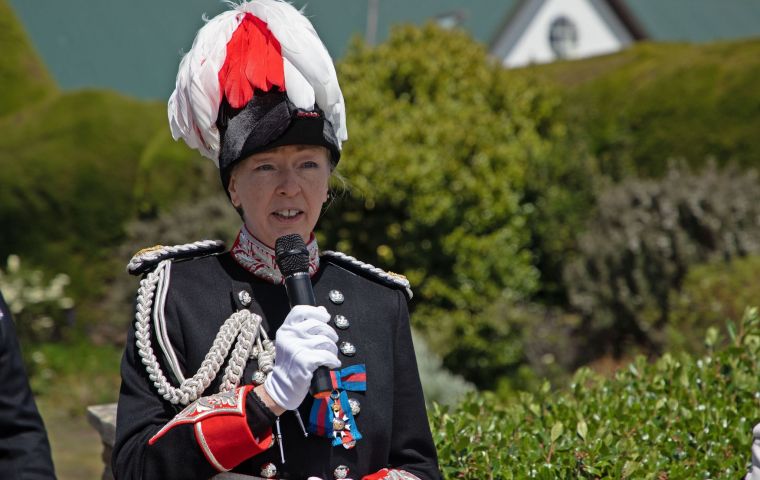MercoPress. South Atlantic News Agency
Falklands: consultation on ceremonial Governor's uniform, tradition or modernity?
 Her Excellency The Governor, Alison Blake CMG, wearing her ceremonial uniform
Her Excellency The Governor, Alison Blake CMG, wearing her ceremonial uniformThe Falkland Islands Legislative Assembly is seeking public views on whether or not to continue the use of the ceremonial uniform of the Governor. This consultation seeks to get a sense of the view of the public in regards to the use of a ceremonial gubernatorial uniform. The response period closes Sunday 20th April.
While it represents long-standing traditions associated with the role, there are differing views on whether the uniform remains relevant in a modern Falkland Islands. The current uniform is worn by Governors at a number of ceremonial events: Liberation Day, The Monarch's Birthday, and Remembrance Sunday.
The Governor's uniform falls under the tradition of British court uniforms, and the Falkland Islands ceremonial gubernatorial uniform is in the style of a British Governor-General Uniform: a plain blue coat; scarlet collar and cuffs (embroidered in silver); silver epaulettes, trimmings, and aiguillette; white gloves; and a hat plumed with real swan feathers to represent The Monarchy.
The ceremonial uniform also includes a Mameluke sword (historically derived from rulers of Egypt) which has been passed down from one governor to the next since the 1990s.
Since 2001 it has been policy of the relationship between British Overseas Territories and the United Kingdom that territories wishing their Governors to keep their ceremonial uniforms pay for them themselves.
British Overseas Territories which maintain a ceremonial gubernatorial uniform: Bermuda and The Falkland Islands.
British Overseas Territories which no longer use a Gubernatorial uniform: Anguilla, The British Virgin Islands, The Cayman Islands, Gibraltar, Montserrat, St Helena.
Some identified differing views include:
• In favour: The uniform of The Governor represents long-standing traditions associated with the status of the Falklands as part of the British global family.
• Against: Only one clothing company in London provides the unique uniform, which is made-to-measure for each Governor, and costs approximately £15,000 to £20,000 to be made, and is paid for by the Falkland Islands Government.
• In favour: The uniform differentiates between the more ceremonial role of the Governor and the decision-making role of elected members.
• Against: The uniform has colonial connotations and is sometimes interpreted to represent the Falklands as a colony in a manner not in keeping with the modern Falkland Islands.
• In favour: Ceremonial traditions are sometimes valued as part of the Islands' cultural identity and can be visually striking for public occasions, media, and tourism.
• Against: The uniform is worn at a smaller number of occasions today and may be considered a costly investment for limited ceremonial use.




Top Comments
Disclaimer & comment rules-

-

-

Read all commentsBetter still Libby, all you Spanish Italians and Germans return back to Europe and give the land back to the natives, the British where hardly chickens when they kicked your ass in 1982 after an illegal invasion, its you who where the Turkeys who got plucked stuffed and roasted, idiot,
Apr 20th, 2025 - 06:25 pm +6Liberato
Apr 21st, 2025 - 01:45 pm +2The last time Argentina did something silly they got well and truly 'plucked' didn't they.
By the way as far as I can see there are no 'plums' in the ceremonial headdress.
“I dont like the uks colonial attitudes. As im sure you dont respect the mutilation of genitals of women in Africa or the Animal sacrifice to God involving mass ritual slaughter, etc.”
Apr 23rd, 2025 - 03:07 pm +1And of course there is a colonial Argentine attitude!
“At the end of the colonial period, Blacks constituted approximately a third of the urban population. According to the census of 1887 and the opinions of contemporary observers, the urban Black population declined numerically to roughly half its colonial size and fell to an inconsequential 2 percent of total population by the end of the century. How did the Black population of Buenos Aires disappear?
It is widely reported that president of Argentina from 1868 to 1874, Domingo Faustino Sarmiento, undertook a ‘covert genocide’ that wiped out the Afro-Argentinean population to the point that by 1875, there were so little Black people left in Argentina that the government didn’t even bother registering African-descendants in the national census.”
https://afropunk.com/2018/07/argentinas-black-population-has-been-systematically-erased-removed-in-whitewashing-effort/
Commenting for this story is now closed.
If you have a Facebook account, become a fan and comment on our Facebook Page!